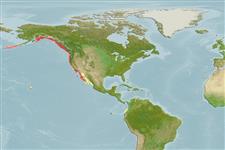Asteroidea |
Valvatida |
Asterinidae
Environment: milieu / climate zone / depth range / distribution range
Ecology
Benthic; depth range 0 - 302 m (Ref. 93256). Subtropical
Northeast Pacific: Alaska to Gulf of California. Subtropical to temperate.
Length at first maturity / Size / Weight / Age
Maturity: Lm ? range ? - ? cm Max length : 20.0 cm WD male/unsexed; (Ref. 865)
Found on rocks, broken shells, gravel and sand on exposed coasts but not on areas under direct influence of the surf (Ref. 93256).
Life cycle and mating behavior
Maturity | Reproduction | Spawning | Eggs | Fecundity | Larvae
Members of the class Asteroidea exhibit both asexual (regeneration and clonal) and sexual (gonochoric) means of reproduction. Life cycle: Embryos hatch into planktonic larvae and later metamorphose into pentamorous juveniles which develop into young sea stars with stubby arms.
Lambert, P. 2000 Sea stars of British Columbia, Southeast Alaska and Puget Sound. Canada: UBC Press. 186 p. (Ref. 93256)
IUCN Red List Status
(Ref. 130435: Version 2025-1)
CITES status (Ref. 108899)
Not Evaluated
Not Evaluated
Threat to humans
Human uses
| FishSource |
Tools
More information
Population dynamicsGrowth
Max. ages / sizes
Length-weight rel.
Length-length rel.
Length-frequencies
Mass conversion
Abundance
Life cycleReproductionMaturityFecunditySpawningEggsEgg developmentLarvae Human RelatedStamps, coins, misc.
Internet sources
Estimates based on models
Preferred temperature
(Ref.
115969): 7.1 - 11.6, mean 8.4 (based on 38 cells).
Fishing Vulnerability
Low vulnerability (10 of 100).
Price category
Unknown.
